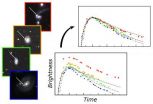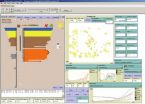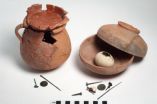(Press-News.org) Sixteen years ago two teams of supernova hunters, one led by Saul Perlmutter of the U.S. Department of Energy's Lawrence Berkeley National Laboratory (Berkeley Lab), the other by Brian Schmidt of the Australian National University, declared that the expansion of the universe is accelerating – a Nobel Prize-winning discovery tantamount to the discovery of dark energy. Both teams measured how fast the universe was expanding at different times in its history by comparing the brightnesses and redshifts of Type Ia supernovae, the best cosmological "standard candles."
These dazzling supernovae are remarkably similar in brightness, given that they are the massive thermonuclear explosions of white dwarf stars, which pack roughly the mass of our sun into a ball the size of Earth. Based on their colors and how fast they brighten and fade away, the brightnesses of different Type Ia supernovae can be standardized to within about 10 percent, yielding accurate gauges for measuring cosmic distances.
Until recently, scientists thought they knew why Type Ia supernovae are all so much alike. But their favorite scenario was wrong.
The assumption was that carbon-oxygen white dwarf stars, the progenitors of the supernovae, capture additional mass by stripping it from a companion star or by merging with another white dwarf; when they approach the Chandrasekhar limit (40 percent more massive than our sun) they experience thermonuclear runaway. Type Ia brightnesses were so similar, scientists thought, because the amounts of fuel and the explosion mechanisms were always the same.
"The Chandrasekhar mass limit has long been put forward by cosmologists as the most likely reason why Type Ia supernovae brightnesses are so uniform, and more importantly, why they are not expected to change systematically at higher redshifts," says cosmologist Greg Aldering, who leads the international Nearby Supernova Factory (SNfactory) based in Berkeley Lab's Physics Division. "The Chandrasekhar limit is set by quantum mechanics and must apply equally, even for the most distant supernovae."
But a new analysis of normal Type Ia supernovae, led by SNfactory member Richard Scalzo of the Australian National University, a former Berkeley Lab postdoc, shows that in fact they have a range of masses. Most are near or slightly below the Chandrasekhar mass, and about one percent somehow manage to exceed it.
The SNfactory analysis has been accepted for publication by the Monthly Notices of the Royal Astronomical Society and is available online as an arXiv preprint at http://xxx.lanl.gov/abs/1402.6842v1.
A new way to analyze exploding stars
While white dwarf stars are common, Scalzo says, "it's hard to get a Chandrasekhar mass of material together in a natural way." A Type Ia starts in a two-star (or perhaps a three-star) system, because there has to be something from which the white dwarf accumulates enough mass to explode.
Some models picture a single white dwarf borrowing mass from a giant companion. However, says Scalzo, "The most massive newly formed carbon-oxygen white dwarfs are expected to be around 1.2 solar masses, and to approach the Chandrasekhar limit a lot of factors would have to line up just right even for these to accrete the remaining 0.2 solar masses."
If two white dwarfs are orbiting each other they somehow have to get close enough to either collide or gently merge, what Scalzo calls "a tortuously slow process." Because achieving a Chandrasekhar mass seems so unlikely, and because sub-Chandrasekhar white dwarfs are so much more numerous, many recent models have explored how a Type Ia explosion could result from a sub-Chandrasekhar mass – so many, in fact, that Scalzo was motivated to find a simple way to eliminate models that couldn't work.
He and his SNfactory colleagues determined the total energy of the spectra of 19 normal supernovae, 13 discovered by the SNfactory and six discovered by others. All were observed by the SNfactory's unique SNIFS spectrograph (SuperNova Integral Field Spectrograph) on the University of Hawaii's 2.2-meter telescope on Mauna Kea, corrected for ultraviolet and infrared light not observed by SNIFS.
A supernova eruption thoroughly trashes its white dwarf progenitor, so the most practical way to tell how much stuff was in the progenitor is by spectrographically "weighing" the leftover debris, the ejected mass. To do this Scalzo took advantage of a supernova's layered composition.
A Type Ia's visible light is powered by radioactivity from nickel-56, made by burning carbon near the white dwarf's center. Just after the explosion this radiation, in the form of gamma rays, is absorbed by the outer layers – including iron and lighter elements like silicon and sulfur, which consequently heat up and glow in visible wavelengths.
But a month or two later, as the outer layers expand and dissipate, the gamma rays can leak out. The supernova's maximum brightness compared to its brightness at late times depends on how much gamma radiation is absorbed and converted to visible light – which is determined both by the mass of nickel-56 and the mass of the other material piled on top of it.
The SNfactory team compared masses and other factors with light curves: the shape of the graph, whether narrow or wide, that maps how swiftly a supernova achieves its brightest point, how bright it is, and how hastily or languorously it fades away. The typical method of "standardizing" Type Ia supernovae is to compare their light curves and spectra.
"The conventional wisdom holds that the light curve width is determined primarily or exclusively by the nickel-56 mass," Scalzo says, "whereas our results show that there must also be a deep connection with the ejected mass, or between the ejected mass and the amount of nickel-56 created in a particular supernova."
Exploding white dwarf stars, the bottom line
Greg Aldering summarizes the most basic result of the new analysis: "The white dwarfs exploding as Type Ia supernovae have a range of masses, and the resulting light-curve width is directly proportional to the total mass involved in the explosion."
For a supernova whose light falls off quickly, the progenitor is a lot less massive than the Chandrasekhar mass – yet it's still a normal Type Ia, whose luminosity can be confidently standardized to match other normal Type Ia supernovae.
The same is true for a Type Ia that starts from a "classic" progenitor with Chandrasekhar mass, or even more. For the heavyweights, however, the pathway to supernova detonation must be significantly different than for lighter progenitors. These considerations alone were enough to eliminate a number of theoretical models for Type Ia explosions.
Carbon-oxygen white dwarfs are still key. They can't explode on their own, so another star must provide the trigger. For super-Chandrasekhar masses, two C-O white dwarfs could collide violently, or one could accrete mass from a companion star in a way that causes it to spin so fast that angular momentum supports it beyond the Chandrasekhar limit.
More relevant for cosmolology, because more numerous, are models for sub-Chandrasekhar mass. From a companion star, a C-O white dwarf could accumulate helium, which detonates more readily than carbon – the result is a double detonation. Or two white dwarfs could merge. There are other surviving models, but the psychological "safety net" that the Chandrasekhar limit once provided cosmologists has been lost. Still, says Scalzo, the new analysis narrows the possibilities enough for theorists to match their models to observations.
"This is a significant advance in furthering Type Ia supernovae as cosmological probes for the study of dark energy," says Aldering, "likely to lead to further improvements in measuring distances. For instance, light-curve widths provide a measure of the range of the star masses that are producing Type Ia supernovae at each slice in time, well back into the history of the universe."
INFORMATION:
This work was supported by DOE's Office of Science and the Gordon and Betty Moore Foundation, and in France by CNRS/IN2P3 (National Center for Scientific Research, National Institute of Nuclear and Particle Physics), CNRS/INSU (CNRS National Institute for Earth Sciences and Astronomy), and PNC (Programme National de Cosmologie).
"Type Ia Supernova Bolometric Light Curves and Ejected Mass Estimates from the Nearby Supernova Factory," by Richard Scalzo, Greg Aldering, Pierre Antilogus, Cecilia Aragon, Stephen Bailey, Charles Baltay, Sébastien Bongard, Clement Buton, Flora Cellier-Holzem, Mike Childress, Nicolas Chotard, Yannick Copin, Hannah K. Fakhouri, Emmanuel Gangler, Julien Guy, Alex Kim, Marek Kowalski, Markus Kromer, Jakob Nordin, Peter Nugent, Kerstin Paech, Reynald Pain, Emmanuel Pécontal, Rui Pereira, Saul Perlmutter, David Rabinowitz, Mickael Rigault, Karl Runge, Clare Saunders, Stuart Sim, Gerard Smadja, Charling Tao, Stefan Taubenberger, Rollin Thomas, and Benjamin Alan Weaver (The Nearby Supernova Factory), will appear in the Monthly Notices of the Royal Astronomical Society and is available online as an arXiv preprint at http://xxx.lanl.gov/abs/1402.6842v1.
The researchers acknowledge the assistance of the University of Hawaii 2.2-meter telescope, the W. M. Keck Observatory, Lick Observatory, Southern Astrophysical Research telescope (SOAR), the Palomar Observatory, QUEST-II collaboration, and High Performance Wireless Research and Education Network (HPWREN) in obtaining the data, and DOE's National Energy Research Scientific Computing Center (NERSC) for storage and computing time.
The Nearby Supernova Factory is a scientific collaboration between the Centre de Recherche Astronomique de Lyon, Institut de Physique Nucléaire de Lyon, Laboratoire de Physique Nucléaire et des Hautes Energies, Lawrence Berkeley National Laboratory, Yale University, University of Bonn, Max Planck Institute for Astrophysics, Tsinghua Center for Astrophysics, and the Centre de Physique des Particules de Marseille. The ARC Centre of Excellence for All‐sky Astrophysics (CAASTRO) is a collaboration between The University of Sydney, The Australian National University, The University of Melbourne, Swinburne University of Technology, The University of Queensland, The University ofb Western Australia, and Curtin University.
Lawrence Berkeley National Laboratory addresses the world's most urgent scientific challenges by advancing sustainable energy, protecting human health, creating new materials, and revealing the origin and fate of the universe. Founded in 1931, Berkeley Lab's scientific expertise has been recognized with 13 Nobel prizes. The University of California manages Berkeley Lab for the U.S. Department of Energy's Office of Science. For more, visit http://www.lbl.gov.
The DOE Office of Science is the single largest supporter of basic research in the physical sciences in the United States and is working to address some of the most pressing challenges of our time. For more information, please visit science.energy.gov.
Standard-candle supernovae are still standard, but why?
The Nearby Supernova Factory based at Berkeley Lab shows that Type Ia supernovae have a surprisingly large range of masses
2014-03-04
ELSE PRESS RELEASES FROM THIS DATE:
Virtual bees help to unravel complex causes of colony decline
2014-03-04
Scientists have created an ingenious computer model that simulates a honey bee colony over the course of several years. The BEEHAVE model, published today in the Journal of Applied Ecology, was created to investigate the losses of honeybee colonies that have been reported in recent years and to identify the best course of action for improving honeybee health.
A team of scientists, led by Professor Juliet Osborne from the Environment and Sustainability Institute, University of Exeter (and previously at Rothamsted Research), developed BEEHAVE, which simulates the life of ...
Sardis dig yields enigmatic trove: Ritual egg in a pot
2014-03-04
MADISON, Wis. — By any measure, the ancient city of Sardis — home of the fabled King Croesus, a name synonymous with gold and vast wealth, and the city where coinage was invented — is an archaeological wonder.
The ruins of Sardis, in what is now Turkey, have been a rich source of knowledge about classical antiquity from the 7th century B.C., when the city was the capital of Lydia, through later Greek and Roman occupations.
Now, however, Sardis has given up another treasure in the form of two enigmatic ritual deposits, which are proving more difficult to fathom than ...
World-class orchestras judged by sight not sound
2014-03-04
World-class orchestras can be accurately identified by silent video footage of performances, but not through sound recordings, a UCL study has found.
Both professional musicians and musical novices are better at identifying top-ranked orchestras from non-ranked orchestras when shown silent video footage, suggesting that such judgements are driven at least in part by visual cues about group dynamics and leadership.
When shown two 6-second clips, one from a world-class orchestra ranked among the top ten internationally - which included the London Symphony Orchestra, the ...
Plant extract offers hope for infant motor neurone therapy
2014-03-04
A chemical found in plants could reduce the symptoms of a rare muscle disease that leaves children with little or no control of their movements.
Scientists have found that a plant pigment called quercetin – found in some fruits, vegetables, herbs and grains – could help to prevent the damage to nerves associated with the childhood form of motor neuron disease.
Their findings could pave the way for new treatments for spinal muscular atrophy (SMA) – also known as floppy baby syndrome – which is a leading genetic cause of death in children.
The team has found that the ...
Yeast model reveals Alzheimer's drug candidate and its mechanism of action
2014-03-04
CAMBRIDGE, Mass. (March 3, 2014) – Using a yeast model of Alzheimer's disease (AD), Whitehead Institute researchers have identified a drug that reduces levels of the toxic protein fragment amyloid-β (Aβ) and prevents at least some of the cellular damage caused when Aβ accumulates in the brains of AD patients.
"We can use this yeast model to find small molecules that will address the underlying cellular pathologies of Alzheimer's, an age-related disease whose burden will become even more significant as our population grows older," says Kent Matlack, a former ...
Childhood adversity launches lifelong relationship and health disadvantages for black men
2014-03-04
AUSTIN, Texas — African American men who endured greater childhood adversity are likely to experience disadvantages in health and relationships over time, according to new sociology research from The University of Texas at Austin.
The study, published in the March issue of the Journal of Health and Social Behavior, helps to explain why African American men are less healthy than white men.
"Exposure to childhood adversity may cause stress and lead to a sequence of stressors over time that take a cumulative toll on relationships," says Debra Umberson, professor of sociology ...
Two studies examine bedroom TVs, active gaming and weight issues in children
2014-03-04
Bottom Line: Having a bedroom television is associated with weight gain in children and adolescents, and is unrelated to the time they spend watching.
Author: Diane Gilbert-Diamond, Sc.D., of the Geisel School of Medicine at Dartmouth, Lebanon, N.H., and colleagues.
Background: More than one-third of children and adolescents in the United States are overweight or obese. An estimated 71 percent of children and adolescents (ages 8 to 18 years) have bedroom televisions.
How the Study Was Conducted: The authors conducted a telephone survey in 2003 of 6,522 boys and girls ...
New research on potent HIV antibodies has opened up possibilities
2014-03-04
The discovery of how a KwaZulu-Natal woman's body responded to her HIV infection by making potent antibodies (called broadly neutralising antibodies, because they are able to kill multiple strains of HIV from across the world), was reported today by the CAPRISA consortium of AIDS researchers jointly with scientists from the United States.
The study, published in the prestigious scientific journal, Nature, describes how the research team found and identified these antibodies in her blood and then duplicated them by cloning the antibodies in the laboratory. The cloned antibodies ...
Distinctive flashing patterns might facilitate fish mating
2014-03-04
Scientists have shown for the first time that deep-sea fishes that use bioluminescence for communication are diversifying into different species faster than other glowing fishes that use light for camouflage. The new research indicates that bioluminescence—a phenomenon in which animals generate visible light through a chemical reaction—could promote communication and mating in the open ocean, an environment with few barriers to reproduction. The study was recently published in the journal Marine Biology.
"Bioluminescence is quite common in the deep sea, and many fishes ...
Quality of life improves with minimally invasive surgery for low back pain
2014-03-04
Beaumont research findings published in the February online issue of Spine shows that patients who have a low back surgery called minimally invasive transforaminal lumbar interbody fusion, end up better off in many ways than patients who have more invasive surgery to alleviate debilitating pain.
"About 90 percent of adults experience low back pain in their lifetime, which can be caused by spinal instability, stenosis, spondylolisthesis, and symptomatic degenerative disc disease," says Mick Perez-Cruet, M.D., neuro-spine surgeon at Beaumont Hospital, Royal Oak and professor, ...
LAST 30 PRESS RELEASES:
B cells transiently unlock their plasticity, risking lymphoma development
Advanced AI dodel predicts spoken language outcomes in deaf children after cochlear implants
Multimodal imaging-based cerebral blood flow prediction model development in simulated microgravity
Accelerated streaming subgraph matching framework is faster, more robust, and scalable
Gestational diabetes rose every year in the US since 2016
OHSU researchers find breast cancer drug boosts leukemia treatment
Fear and medical misinformation regarding risk of progression or recurrence among patients with breast cancer
Glucagonlike peptide-1 receptor agonists and asthma risk in adolescents with obesity
Reviving dormant immunity: Millimeter waves reprogram the immunosuppressive microenvironment to potentiate immunotherapy without obvious side effects
Safety decision-making for autonomous vehicles integrating passenger physiological states by fNIRS
Fires could emit more air pollution than previously estimated
A new way to map how cells choose their fate
Numbers in our sights affect how we perceive space
SIMJ announces global collaborative book project in commemoration of its 75th anniversary
Air pollution exposure and birth weight
Obstructive sleep apnea risk and mental health conditions among older adults
How talking slows eye movements behind the wheel
The Ceramic Society of Japan’s Oxoate Ceramics Research Association launches new international book project
Heart-brain connection: international study reveals the role of the vagus nerve in keeping the heart young
Researchers identify Rb1 as a predictive biomarker for a new therapeutic strategy in some breast cancers
Survey reveals ethical gaps slowing AI adoption in pediatric surgery
Stimulant ADHD medications work differently than thought
AI overestimates how smart people are, according to HSE economists
HSE researchers create genome-wide map of quadruplexes
Scientists boost cell "powerhouses" to burn more calories
Automatic label checking: The missing step in making reliable medical AI
Low daily alcohol intake linked to 50% heightened mouth cancer risk in India
American Meteorological Society announces Rick Spinrad as 2026 President-Elect
Biomass-based carbon capture spotlighted in newly released global climate webinar recording
Illuminating invisible nano pollutants: advanced bioimaging tracks the full journey of emerging nanoscale contaminants in living systems
[Press-News.org] Standard-candle supernovae are still standard, but why?The Nearby Supernova Factory based at Berkeley Lab shows that Type Ia supernovae have a surprisingly large range of masses





